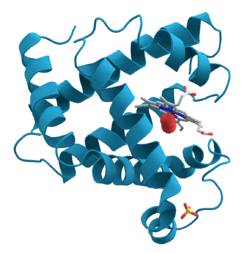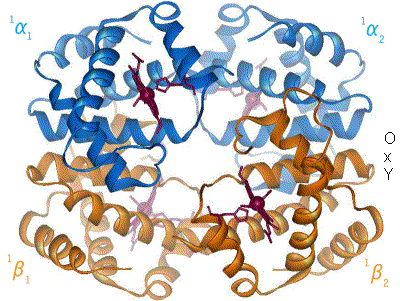Structural biology
| Part of a series on |
| Biochemistry |
|---|
 |
| Key components |
| History and topics |
| Portals: Biology, MCB |
Structural biology is a branch of molecular biology, biochemistry, and biophysics concerned with the molecular structure of biological macromolecules, especially proteins and nucleic acids, how they acquire the structures they have, and how alterations in their structures affect their function.[1] This subject is of great interest to biologists because macromolecules carry out most of the functions of cells, and because it is only by coiling into specific three-dimensional shapes that they are able to perform these functions. This architecture, the "tertiary structure" of molecules, depends in a complicated way on the molecules' basic composition, or "primary structures."

Biomolecules are too small to see in detail even with the most advanced light microscopes. The methods that structural biologists use to determine their structures generally involve measurements on vast numbers of identical molecules at the same time. These methods include:
- Mass spectrometry
- Macromolecular crystallography
- Proteolysis
- Nuclear magnetic resonance spectroscopy of proteins (NMR)
- Electron paramagnetic resonance (EPR)
- Cryo-electron microscopy (cryo-EM)
- Multiangle light scattering
- Small angle scattering
- Ultra fast laser spectroscopy
- Dual-polarization interferometry and circular dichroism
Most often researchers use them to study the "native states" of macromolecules. But variations on these methods are also used to watch nascent or denatured molecules assume or reassume their native states. See protein folding.
A third approach that structural biologists take to understanding structure is bioinformatics to look for patterns among the diverse sequences that give rise to particular shapes. Researchers often can deduce aspects of the structure of integral membrane proteins based on the membrane topology predicted by hydrophobicity analysis. See protein structure prediction.

In the past few years it has become possible for highly accurate physical molecular models to complement the in silico study of biological structures. Examples of these models can be found in the Protein Data Bank.
See also
- Primary structure
- Secondary structure
- Tertiary structure
- Quaternary structure
- Structural domain
- Structural motif
- Protein subunit
- Molecular model
- Cooperativity
- Chaperonin
- Structural genomics
- Stereochemistry
- Resolution (electron density)
- Proteopedia The collaborative, 3D encyclopedia of proteins and other molecules.
- Protein structure prediction
References
External links
| At Wikiversity, you can learn more and teach others about Structural biology at the Department of Structural biology |
- Nature: Structural & Molecular Biology magazine website
- Journal of Structural Biology
- Structural Biology - The Virtual Library of Biochemistry and Cell Biology
- Structural Biology in Europe